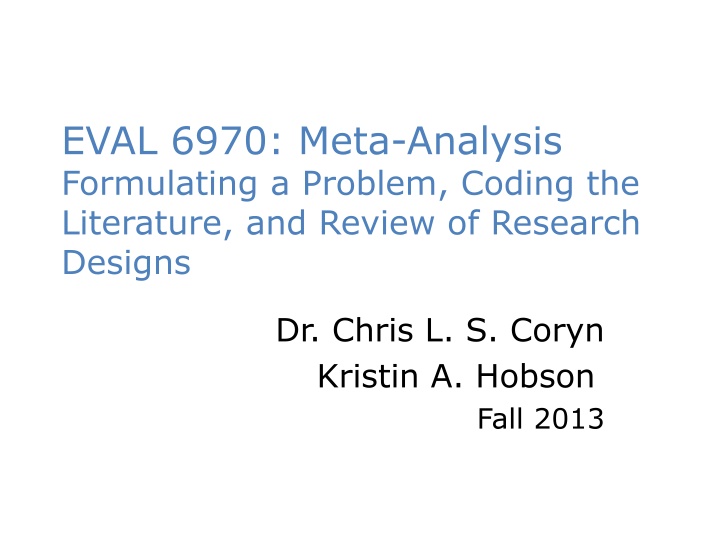
Meta-Analysis in Research: Problem Formulation and Literature Coding
In a Fall 2013 course, Dr. Chris L. S. Coryn and Kristin A. Hobson discussed the critical aspects of meta-analysis, emphasizing the importance of formulating a precise problem statement and effectively coding the literature. They explored research designs and outlined steps for conducting meta-analysis, such as defining the research topic, developing eligibility criteria, and identifying independent and dependent variables. The course also covered primary coding topics like eligibility criteria, coding protocols, data hierarchy, reliability assessment, coder training, and common mistakes to avoid.
Download Presentation

Please find below an Image/Link to download the presentation.
The content on the website is provided AS IS for your information and personal use only. It may not be sold, licensed, or shared on other websites without obtaining consent from the author. If you encounter any issues during the download, it is possible that the publisher has removed the file from their server.
You are allowed to download the files provided on this website for personal or commercial use, subject to the condition that they are used lawfully. All files are the property of their respective owners.
The content on the website is provided AS IS for your information and personal use only. It may not be sold, licensed, or shared on other websites without obtaining consent from the author.
E N D
Presentation Transcript
EVAL 6970: Meta-Analysis Formulating a Problem, Coding the Literature, and Review of Research Designs Dr. Chris L. S. Coryn Kristin A. Hobson Fall 2013
Agenda Formulating a problem Coding the literature Review of research designs In-class activity Next meeting
Formulating a Problem Like any research, meta-analysis should begin with a careful statement of the topic to be investigated or the question to be answered This statement will guide study selection, coding of information, and data analysis
Formulating a Problem The problem statement needs to be straightforward and complete, but at this stage, need not be highly detailed The problem statement will become clearer and more concise when eligibility criteria are developed
Formulating a Problem How effective are challenge programs in reducing the subsequent antisocial behavior of juveniles with behavior problems? What are the characteristics of the least and most successful programs? Do these programs have favorable effects on other outcomes such as relations with peers, locus-of- control, and self-esteem? Lipsey & Wilson (2001)
Formulating a Problem The statement of problem on the prior slide yields a preliminary specification of the research literature at issue (studies of the effects of challenge programs on juveniles with behavior problems), the major category of independent variables (program characteristics), and key dependent variables (antisocial behavior, interpersonal relationships, locus-of- control, and self-esteem)
Primary Coding Topics Eligibility criteria and screening form Development of coding protocol Hierarchical nature of data Assessing reliability of coding Training of coders Common mistakes
Study Eligibility Criteria Flow from research question Identify specifics of: Defining features of the program/policy/intervention Eligible designs and required methods Key sample features Required statistical data Geographic/linguistic restrictions, if any Time frame, if any Also explicitly states what is excluded
Screening Form Develop a screening form with clearly defined criteria Complete form for all studies retrieved as potentially eligible Modify criteria after examining sample of studies (controversial) Double-code eligibility Maintain database on results for each study screened
Development of Coding Protocol Goal of protocol Describe studies Differentiate studies Extract findings (effect sizes if possible) Coding forms and manual Both important
Development of Coding Protocol Types of information to code Report identification Study setting Participants Method Treatment or experimental manipulation Dependent measures Effect sizes Confidence ratings
Development of Coding Protocol Iterative nature of development Structuring data Data hierarchical (findings within studies) Coding protocol needs to allow for this complexity Analysis of effect sizes needs to respect this structure Flat file Relational hierarchical file
Flat File Structure Multiple effect sizes handled by having multiple variables, one for each potential effect size ID 22 23 31 36 40 82 185 186 204 229 246 274 295 626 1366 Paradigm ES1 0.77 0.77 -0.1 0.94 0.96 0.29 0.65 DV1 ES2 DV2 ES3 DV3 ES4 DV4 2 2 1 2 1 1 1 1 2 2 2 2 2 1 2 3 3 5 3 -0.05 5 -0.2 11 11 11 5 0.58 0.83 0.88 5 5 3 0.48 5 0.068 5 0.97 3 0.91 -0.31 6.46 -0.04 0.5 3 3 3 . 3 3 0.86 7.03 0.87 3 3 3 0.79 3 3 3 1.17 0.57 . 0.9 3 0.1 3 Note that there is only one record (row) per study
Hierarchical Structure Study Level Data File ID PubYear MeanAge TxStyle 100 7049 92 82 15.5 14.5 2 1 Effect Size Level Data File Outcome Type ID ESNum TxN 24 24 24 24 24 30 30 30 CgN 24 24 24 24 24 30 30 30 ES Note that a single record in the file above is related to five records in the file to the right 100 100 100 100 100 7049 7049 7049 1 2 3 4 5 1 2 3 1 1 1 1 1 2 4 1 -0.39 0 0.09 -1.05 -0.44 0.34 0.78 0
More Complex Structure Study Level Data File Outcome Level Data File ID OutNum Constrct Scale ID PubYear MeanAge TxStyle 100 100 100 7049 7049 1 2 3 1 2 2 6 4 2 6 1 1 2 4 3 100 7049 92 82 15.5 14.5 2 1 Effect Size Level Data File Note that study 100 has 2 records in the outcomes data file and 6 outcomes in the effect size data file, 2 for each outcome measured at different points in time (Months) ID OutNum ESNum Months TxN 24 22 24 22 24 22 30 29 30 CgN 24 -0.39 22 24 22 -1.05 24 -0.44 21 30 28 30 ES 100 100 100 100 100 100 7049 7049 7049 1 1 2 2 3 3 1 1 2 1 2 3 4 5 6 2 6 2 0 6 0 6 0 6 0 0 0.09 0.34 0.78 0.78 12 0 0
Multiple Flat File Structure Advantages Can grow to any number of effect sizes Reduces coding task (faster coding) Simplifies data cleanup Smaller data files to manipulate Disadvantages Complex to implement Data must be manipulated prior to analysis Must be able to select a single effect size per study for any analysis When to use Large number of effect sizes per study are possible
Working with Flat Files Permanent Data Files Select subset of effect sizes of interest to current analysis (e.g., a specific outcome at posttest) Study Data File Outcome Data File Verify that there is only a single effect size per study Effect Size Data File Create composite data file yes no Average effect sizes, further select based explicit criteria, or select randomly Composite Data File Working Analysis File
What About Sub-Samples? What if you are interested in coding effect sizes separately for different sub-samples, such as, boys and girls or high-risk and low- risk youth? Just say no ! Often not enough of such data for meaningful analysis Complicates coding and data structure If you must, plan your data structure carefully Include a full sample effect size for each dependent measure of interest Place sub-sample in a separate data file or use some other method to reliably determine effect sizes that are statistically dependent
Coding Mechanics Paper Coding Include data file variable names on coding form All data along left or right margin eases data entry Coding into a spreadsheet Coding directly into a database Using forms We will work with databases and form- building in the coming weeks
Coding Directly to Database Advantages Avoids additional step of transferring data from paper to computer Easy access to data for data cleanup Database can perform calculations during coding process (e.g., calculation of effect sizes) Faster coding Can perform queries to extract relevant data Disadvantages Can be time consuming to set up Requires a higher level of computer skill
Databases with Forms FileMaker database form
Databases with Forms Access database form
Reliability of Coding At a minimum, 2 coders per study Best if all coders code all studies (fully- crossed as coder study) Interrater reliability At a minimum Estimate observed agreement Estimate agreement taking probability of chance agreement into account This should be done at several points (e.g., as a test of the coding protocol, for decisions about inclusion/exclusion of studies)
Coefficient of Agreement The coefficient of observed agreement represents the total proportion of observations (?o) on which there is agreement ? ? ?o= ??? ?=1 ?=1 where c denotes the total number of cells, i denotes the ith row, and j denotes the jth column
Coefficient of Agreement Coder 2 Characteristic Present (?1) Characteristic Not Present (?2) Row Total Characteristic Present (?1) Characteristic Not Present (?2) ?11 ?21 ? = ?11+ ?21 Coder 1 ?12 ?22 ? = +?12+ ?22 ? = (?11+ ?12+ ?21+ ?22) Column Total ? = ?11+ ?12 ? = ?21+ ?22 ? ? ???=?11+ ?22 ?o= ? ?=1 ?=1
Coefficient of Agreement Coder 2 Characteristic Present (?1) Characteristic Not Present (?2) Row Total Characteristic Present (?1) Characteristic Not Present (?2) 500 1 501 Coder 1 2 25 27 Column Total 502 26 528 ? ? ???=?11+ ?22 500 + 25 500 + 1 + 2 + 25=525 ?o= = 528= .9943 ? ?=1 ?=1
Cohens Kappa Cohen s kappa (?) represents the extent of agreement exceeding that which would be expected purely by chance ? =?o ?e 1 ?e Where ?e is expected agreements
Cohens Kappa Marginal Row Probabilities Coder 2 Characteristic Present (?1) Characteristic Not Present (?2) ??. Characteristic Present (?1) Characteristic Not Present (?2) ?1.=(?11+ ?21) ?11 ?21 ? Coder 1 ?2.=(?12+ ?22) ?12 ?22 ? Marginal Column Probabilities ?.1=(?11+ ?12) ?.2=(?21+ ?22) ? = (?11+ ?12+ ?21+ ?22) ?.? ? ? ? ? ?e= ??.?.?= ?.1?1.+ ?.2?2. ?=1 ?=1
Cohens Kappa Marginal Row Probabilities Coder 2 Characteristic Present (?1) Characteristic Not Present (?2) ??. Characteristic Present (?1) Characteristic Not Present (?2) ?1.=(500 + 1) 500 1 528 Coder 1 ?2.=(2 + 25) 2 25 528 Marginal Column Probabilities ?.1=(500 + 2) ?.2=(1 + 25) ?.? ? = 528 528 528 ? ? ?e= ??.?.?= ?.1?1.+ ?.2?2.= .9507 .9488 + .0492 .0511 = .9045 ?=1 ?=1 ? =?o ?e 1 ?e =.9943 .9045 1 .9045 =.0898 .0955= .9043
Training and Calibrating Coders Start with a small sub-sample of representative studies (i.e., practice coding) Assess interrater reliability Identify areas of inconsistency/disagreement Modify coding procedures, forms as necessary (reassess after modification) Regular meetings (develop normative understandings) Use specialized coders (e.g., computing effect sizes by hand or using effect size calculators) In the end, a consensus procedure will be necessary for disagreeing codes
Common Mistakes Not understanding or planning the analysis prior to coding (e.g., failure to recognize hierarchical nature and statistical dependencies of some data) Underestimating time, effort, and technical/statistical demands Plan on approximately 8 hours per study for coding Using a spreadsheet for managing a large review Over-coding Trying to extract more detail than routinely reported
Managing the Bibliography Information you need to track Source of reference (e.g., ERIC, PubMed) Retrieval status Retrieved Requested from interlibrary loan Eligibility status Eligible Not eligible Relevant review article Coded status Word processor not up to the task Spreadsheets are cumbersome Use a database of some form
Research Design Review Basic designs that you are likely to encounter Experimental designs Randomized controlled trial Units are randomly assigned to two or more conditions (typically a treatment and a control or comparison group) Most common design is between subjects (e.g., posttest-only design) Can also include a within subjects factor (e.g., a pretest-posttest design)
Research Design Review Basic designs that you are likely to encounter Quasi-experimental designs Similar to randomized controlled trials, except that units are not assigned to conditions randomly One or more groups One-group designs (within subjects) are often in the form of a one-group pretest-posttest Some types of single-subject designs fall in this category as do case-control designs
Research Design Review Basic designs that you are likely to encounter Everything else is generally nonexperimental (in a very broad sense, though many designs that I consider quasi- experimental would be labeled as nonexperimental by others) Cross-sectional, correlational (one point in time, one group) Intact, naturally occurring groups (e.g., males, females) Passive, naturalistic
Todays In-Class Activity Individually, or in your working groups, calculate the coefficient of observed agreement (?o), expected agreement (?e), and Cohen s kappa (?) for problems #1, #2, and #3 on the following slides How reliable is each in terms of observed agreement and taking chance agreements into account?
Problem #1 Coder 2 Experimental Design Other Type of Design Experimental Design Other Type of Design 33 748 Coder 1 679 26 ?o=? ?e=? ? =?
Problem #2 Coder 2 Effect Size Based on Means and Standard Deviations Effect Size Based on t-value or F- value Effect Size Based on Means and Standard Deviations Effect Size Based on t- value or F-value 1,267 48 Coder 1 53 926 ?o=? ?e=? ? =?
Problem #3 Coder 2 Meets Inclusion Criteria Does Not Meet Inclusion Criteria Meets Inclusion Criteria Does Not Meet Inclusion Criteria 345 41 Coder 1 38 326 ?o=? ?e=? ? =?








